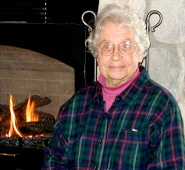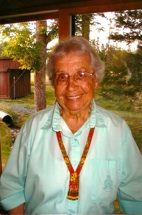Sister Ethel Radhke
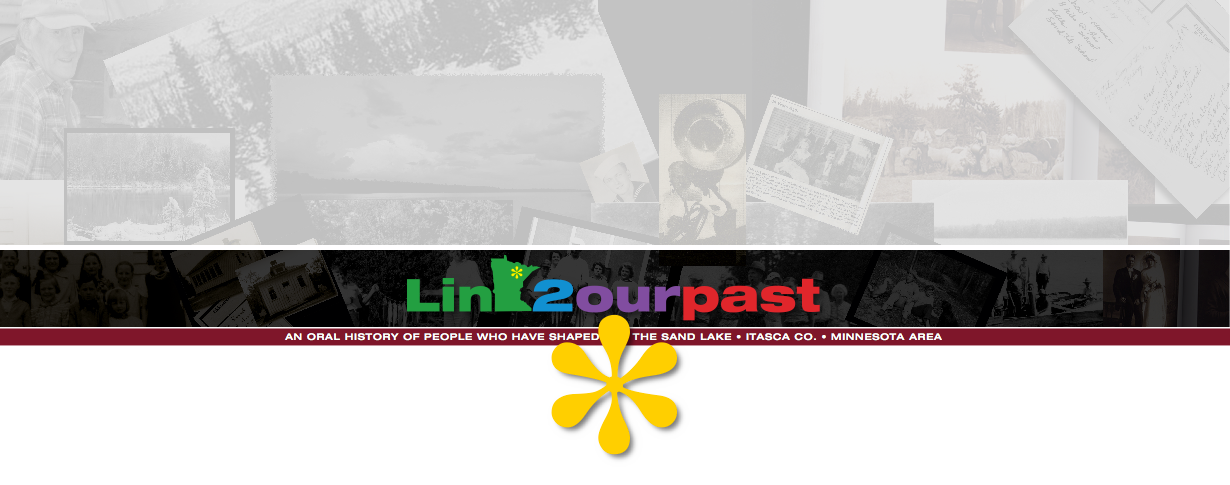




By Bernie Troje
I interviewed Sister Ethel Radhke one Friday morning as we ate breakfast at the Crowbar. She brought boxes of photos to share, but instead we had a spontaneous two hour conversation without the props. It touched upon one obvious and important part of this area – the divide, not connection, between the Native Americans and the rest of us. Yet, as I suspected, I think the interview shows that Sister Ethel became a bridge between the two.
At least one reason this happened is that, first of all, some nuns can be non-threatening. Sister Ethel is one of those. This made it possible for her to know many Native Americans and their culture. She respected them and appreciated their ways. Another reason is that Sister had other connections and was able to acquire some titles as well. These made it possible for her to assist many people as she became aware of their needs.
Her intention, of course, was never to proselytize for the church or on behalf of the white culture. In fact, she admires how Indian spirituality satisfies their needs and how their way of life keeps them in touch with their life source. It saddened Sister to find an old issue of ‘The Minnesota Quarterly’ of the Minnesota Historical Society describe the White Earth Benedictines Christianizing the Indians in the early 1900’s. Sister Ethel feels the Native Americans here sense many of us do not understand or respect their way of life. If this is true, there probably are many reasons for it, and we remain two separate communities in most ways.
Sister Ethel’s background perhaps explains her sensitivity to this issue. She grew up in Two Rivers, Wisconsin. It’s thirty miles southeast of Green Bay. Literally, two rivers come together and form a harbor on Lake Michigan. The safety of the harbor spawned commercial and trophy fishing. Sister remembers the piers being built and the large boats docked by them.
Her father was a Lutheran; her mother a French Catholic. They lived in a large house, and teachers from her school rented rooms on their second floor. Each day her mother prepared lunch for a dozen or so teachers who’d walk over from school for a home-cooked meal.
After a full career as a teacher herself, including teaching biology at St. Scholastica, Sister Ethel began spending her “retirement” years in Squaw Lake as a pastoral assistant.
Those years say a lot about what community is – people coming together and making connections. Sister Ethel has become a part of many of our lives, and the enrichment has flowed both ways.
When we met for breakfast Sister had already returned to the Monastery to begin her real retirement – some thirty-five years after her first. Now she was on an extended weekend visit to her “family,” staying at the Hill Motel, making plans to see Rosie, the black lab she hand to leave behind when she returned to Duluth the previous fall. She’d already been back three times, most recently for the annual St. Urho’s Day Parade.
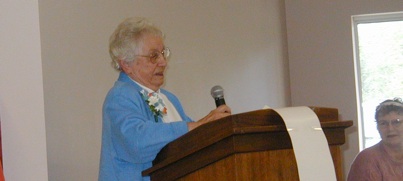
St. Urho, a mythical Finn, rid Finland of its grasshoppers to save the grapes. In previous years the Hill made a Finnish fish chowder, moyaka, for the parade. Evy and Rodney Oja, who own the flea market, once made a large green grasshopper float, the only one for the parade. Sister said she was invited to be the antique lady riding in the parade’s antique car from Mertes’ Garage.
Sister says the area is made up of Indian and Finndians, names that might suggest two separate communities that live among each other.
When Sister Ethel first came to the Squaw Lake area in the early 70’s, her 50’s, the Indian community was geographically separate. They lived on land divided into plots for ricing, for winter hunting, for fishing, and for berry picking. The families built birch bark huts at each site and moved for each season’s activities.
Sister lived at Chippewa Resort on the second floor of the lodge back then. The Hewitts owned the resort. She remembers a snowy fall day when the volunteer crew came to take a pregnant Mrs. Hewitt to the hospital. As she was getting into the ambulance, the deer hunters staying at the resort yelled, “Bring back a boy.” At the birth of the Hewitt’s first child, a daughter, Sister Ethel became the “upstairs grandmother.” She also became the children’s swimming instructor as the family grew.
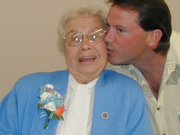
In the 70’s as the area began to reflect the political changes in the country, the Native Americans were recognized as a minority and were eligible for government-funded programs. Sister Ethel worked with Luella Sealy to get funds from the Community Action Program.
As Sister saw the needs among the people, she often went to the county and the reservation council. There were “brilliant men on the tribal councils. They had organizations in the tribes that funneled funds” to appropriate programs, she noted.
Sister got to know all the important contacts, such as then Sheriff Pat Medura. She became a member of the CAP board as one of two mandatory non-Indians. Because government programs under-scored the need for titles, she said, “I had to hurry and get me a title.” Sister became an ombudsman for the Ojibwa in the Squaw Lake area.
With funds from another source, the Johnson-O’Malley Program, which supported extra-curriculars in the schools, she became a tutor at the elementary school. At her suggestion a Native American was put on the Johnson-O’Malley board.
Sister Ethel taught make-up summer school for elementary children and took them swimming in the afternoon. Some afternoons she’d load them into her Jeep Wagoneer and take them to nature movies and programs at the Cut Foot Sioux Visitor Information Center.
One summer she was invited by Elizabeth Boyd to use the school building for enrichment programs. The children worked with beads and birch bark and wrote items for their own newspaper ‘Wannabojeau’ (a legendary Indian who played tricks) printing it on ditto machines. Sister said what these students wrote was “great. Of course, they’re grandparents now.”
There was also money available from the Johnson-O’Malley Program to hire buses for field trips, especially to Native American Museums. Sister said, “We each had an Indian name of an animal.” The children called her ‘Wabekakotoo,’ which means “white owl,” perhaps a reference to her grey hair.
When Sister discovered many Native Americans had no high school diploma and there was no local GED program, she started one, two nights a week, one at Inger and one at Ball Club. These students had talents, she pointed out, but working in the woods for months at a time kept them from completing high school. With a GED, the graduates could go on to the local two-year colleges in Grand Rapids and Bemidji.
Sister Ethel’s connection to Native Americans has given her an appreciation for their culture and respect for their spirituality. Yet she realizes we’re a divided community. From the white perspective, the Native Americans are quiet and reticent. Sister believes Indians feel we don’t understand their culture, so they don’t feel free to share important parts of their lives. Sister sees a “rich culture [with] a beautiful, deeply spiritual concept of their world. They respect the spirits of their environment. This shows up in their prayers.” But this is “private to them.”
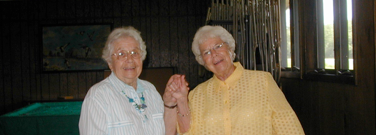
The time Sister Ethel spent in the Squaw Lake area is what gave her a respect for their “innermost” which suggests the spirituality in their daily lives. A pattern of behavior became clear to her as the Indians would visit her at home. They’d wait for her to come outside, and they wouldn’t come directly to the point of their visit. She knew they had a purpose, but learned to wait for them to make it clear. When she asked an Indian friend about this, she was told, “We don’t want to disturb your innermost.”
Not rushing into their reason for being there for fear of disturbing someone’s space, as we would call it, is quite unlike our white culture behavior, Sister observed. We’ve lost, or perhaps never had, that sensitivity. Sister feels discovering our space, our innermost, might help us find out we’re lonely and need to reach out to others to build community, to acknowledge our need for each other.
As we were leaving the Crowbar, we ran into Steve Downs, a friend of Sister’s, a member of the Kiska family which celebrated 100 years in Squaw Lake in 2006. Downs mentioned their family reunion to mark the occasion was later that summer. Sister said she was overjoyed to have yet another excuse to come back soon. Downs had suffered a heart attack a year before. Sister asked him if he was still following doctor’s orders to walk every day. He assured her he was.
Sister Ethel Radhke has been our path through the woods. In her pastoral ministry here, she has given two separated parts of us an experience of each other. Is it a stretch to say the labor of her retired years has brought the spirit of each a bit closer?
...some nuns can be non-threatening. Sister Ethel is one of those. This made it possible for her to know many Native Americans and their culture.
Sister said, “We each had an Indian name of an animal.” The children called her ‘Wabekakotoo,’ which means “white owl,” perhaps a reference to her grey hair.
